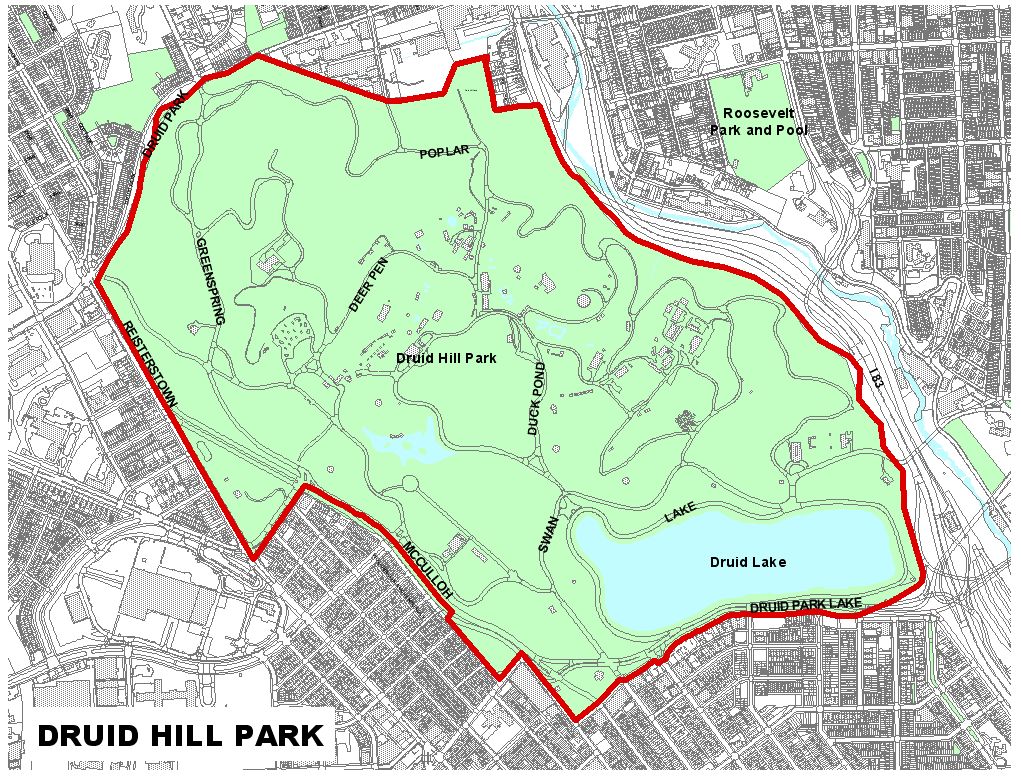Druid Hill Park
National Register of Historic Places 2/1/69
Description
 Druid Hill Park is a 746-acre public park district which lies east of Reisterstown Road and east of Swann Drive, north of Cloverdale Road, west of the Jones Falls Expressway, and south of Druid Hill Drive. The landscaping and park structures were designed as an ensemble. Most of the original buildings are still intact. The park is characterized by a dam, an old boat lake (now a part of the zoological exhibit), several natural springs, and miles of old carriage and bridle paths which traverse the wooded parkland.
Druid Hill Park is a 746-acre public park district which lies east of Reisterstown Road and east of Swann Drive, north of Cloverdale Road, west of the Jones Falls Expressway, and south of Druid Hill Drive. The landscaping and park structures were designed as an ensemble. Most of the original buildings are still intact. The park is characterized by a dam, an old boat lake (now a part of the zoological exhibit), several natural springs, and miles of old carriage and bridle paths which traverse the wooded parkland.
Well known areas include the Prospect and Tempest Hills, which are famous for their vistas, Philosopher's Walk, Terrapin's Back, Reservoir Hill, and the Dell. Among the more important structures are the arched gateway at Madison Avenue and Druid Hill Lake Drive, the Boat House, a part of the Chinese Station, the Conservatory or Palm House, the Octagonal Shelter, the Chess and Checkers Pavilion, and the 19th century early Federal style mansion. Also included within the park district is the Rogers family cemetery behind the mansion house and several statues, including the most widely known Columbus and George Washington Statues dating from the late 19th century. A major portion of the park remains as originally planned.
Significance
Druid Hill Park, dedicated by Mayor Thomas Swann on October 19, 1860, ranks with Central Park in New York and Fairmount Park in Philadelphia as the oldest major public parks in the country. The park is a harmony of color and natural beauty designed by Howard Daniels, Baltimore Park Commissioners' landscape architect, George A. Frederick, architect of many of the park structures, and John H.B. Latrobe, who designed the gateways to the park and the alterations to the 19th century Rogers mansion.
Druid Hill Park was financed by a city tax which was levied on the gross receipts from the privately franchised street railways. Noted structures included a dam which was designated by the American Society of Engineers as an Engineering Landmark in 1971, statues by Achille Canessa (Columbus Statue) and Edward S. Bartholomew (George Washington Statue) and the Rogers family plot. Fifteen of the Druid Hill Park structures were also designated Baltimore City Landmarks in 1975, some of which include the arched gateway, the Chinese Station designed by George A. Frederick and erected in 1864, the Conservatory of 1888, the Octagonal Shelter for the Park Commissioner's horses, and the early 19th century Federal style house built by Colonel Nicholas Rogers and later altered by John H.B. Latrobe.
Some 20th century additions to the park include picnic groves and shelters, facilities for tennis, baseball, lacrosse, archery, swimming and an excellent zoological exhibit, as well as a Children's Zoo.